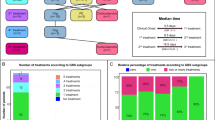Abstract
Introduction
There are no many data on association between progression rate of Guillain-Barré syndrome (GBS) and disease outcome.
Aim
The aim of our study was to analyze short-term outcome of GBS in relation to the rate of disease progression.
Methods
Our retrospective study included patients diagnosed with GBS in seven tertiary healthcare centers from 2009 to 2014. According to the rate of disease progression from onset of symptoms to the nadir, patients were divided in three groups: rapid-onset GBS (nadir reached in maximum 48 h), gradual-onset (nadir reached in three to 14 days), and slow-onset (nadir in 15 to 28 days). GBS disability scale (GDS) was used to assess functional disability at nadir and on discharge.
Results
Among 380 patients included in the study, 24 (6.3%) patients had rapid-onset, 274 (72.1%) gradual-onset, and 82 (21.6%) slow-onset GBS. Time from the onset of the disease to the hospital admission was much shorter in faster-onset forms (3.0 ± 4.1 days in rapid-onset vs. 6.8 ± 9.5 days in gradual-onset and 21.0 ± 9.6 days in slow-onset GBS, p < 0.01). Preceding events were less commonly identified in slow-onset forms. Patients with rapid-onset GBS were more likely to have axonal variants (p < 0.05). All three groups of patients were treated in a similar way, and there were no differences in GDS score at nadir (p > 0.05) and on discharge (p > 0.05) and no differences in the duration of hospital stay.
Conclusion
Faster progression of GBS does not imply a poorer short-term functional outcome of the disease.
Similar content being viewed by others
References
Kuwabara S (2014) Guillain-Barré syndrome: epidemiology, pathophysiology and management. Drugs 64(6):597–610. https://doi.org/10.2165/00003495-200464060-00003
Hughes RA, Cornblath DR (2005) Guillain-Barré syndrome. Lancet 366(9497):1653–1666. https://doi.org/10.1016/S0140-6736(05)67665-9
Ang CW, Jacobs BC, Laman JD (2004) The Guillain-Barré syndrome: a true case of molecular mimicry. Trends Immunol 25(2):61–66. https://doi.org/10.1016/j.it.2003.12.004
Mateen FJ, Cornblath DR, Jafari H, Shinohara RT, Khandit D, Ahuja B, Bahl S, Sutter RW (2011) Guillain-Barré syndrome in India: population-based validation of the Brighton criteria. Vaccine 29(52):9697–9701. https://doi.org/10.1016/j.vaccine.2011.09.123
Arami MA, Yazdchi M, Khandaghi R (2006) Epidemiology and characteristics of Guillain-Barré syndrome in the northwest of Iran. Ann Saudi Med 26(1):22–27. https://doi.org/10.5144/0256-4947.2006.22
Chiò A, Cocito D, Leone M et al (2003) Guillain-Barré syndrome: a prospective, population-based incidence and outcome survey. Neurology 60(7):1146–1150. https://doi.org/10.1212/01.WNL.0000055091.96905.D0
The Italian Guillain-Barré Study Group (1998) The prognosis and main prognostic indicators of Guillain-Barré syndrome: a multicentre prospective study of 297 patients. Brain 119(Pt 6):2053–2061
Winer JB, Hughes RA, Osmond C (1988) A prospective study of acute idiopathic neuropathy. I Clinical features and their prognostic value. J Neurol Neurosurg Psychiatry 51:605–612. https://doi.org/10.1136/jnnp.51.5.605
Van den Berg B, Bunschoten C, van Doorn PA et al (2013) Mortality in Guillain-Barre syndrome. Neurology 80(18):1650–1654. https://doi.org/10.1212/WNL.0b013e3182904fcc
Steiner I, Wirguin I, Blumen SC, Dano M, Raphaeli G, Schwartz I, Korn-Lubetzki I (2008) 'Hyperacute' Guillain-Barré syndrome. Eur Neurol 59(1–2):88–90. https://doi.org/10.1159/000109575
Bakshi N, Maselli RA, Gospe SM Jr et al (1997) Fulminant demyelinating neuropathy mimicking cerebral death. Muscle Nerve 20:1595–1597. https://doi.org/10.1002/(SICI)1097-4598(199712)20:12<1595::AID-MUS17>3.0.CO;2-#
Friedman Y, Lee L, Wherrett JR, Ashby P, Carpenter S (2003) Simulation of brain death from fulminant deefferentation. Can J Neurol Sci 30:397–404. https://doi.org/10.1017/S0317167100003152
Rigamonti A, Basso F, Stanzani L, Agostoni E, Lauria G (2009) Guillain-Barré syndrome mimicking brain death. J Peripher Nerv Syst 14:316–319. https://doi.org/10.1111/j.1529-8027.2009.00244.x
de Montaudouin M, Fleury O, Rouanet M et al (2014) Hyperacute Guillain-Barré syndrome mimicking stroke: report of 3 cases: Guillain-Barré and stroke. Am J Emerg Med 32(9):1152.e3–1152.e5. https://doi.org/10.1016/j.ajem.2014.02.019
Vinay B, Sonia B, Badrinarayan V (2015) Hyperacute onset of Guillain Barre syndrome in the immediate postpartum period following caesarean section under spinal anaesthesia. Indian J Anaesth 59(6):391–392. https://doi.org/10.4103/0019-5049.158782
Synmon B, Saxena SK, Verma A et al (2011) Hyper-acute Guillain-Barré syndrome presenting as respiratory failure. J Ind Acad Cli Med 13(1):70–71
Palace JA, Hughes RA (1994) Guillain-Barré syndrome with severe persistent disability: relationship to hyperacute Guillain-Barré syndrome. Eur J Neurol 1(1):21–27. https://doi.org/10.1111/j.1468-1331.1994.tb00046.x
Sejvar JJ, Kohl KS, Gidudu J, Amato A, Bakshi N, Baxter R, Burwen DR, Cornblath DR, Cleerbout J, Edwards KM, Heininger U, Hughes R, Khuri-Bulos N, Korinthenberg R, Law BJ, Munro U, Maltezou HC, Nell P, Oleske J, Sparks R, Velentgas P, Vermeer P, Wiznitzer M, Brighton Collaboration GBS Working Group (2011) Guillain-Barré syndrome and fisher syndrome: case definitions and guidelines for collection, analysis, and presentation of immunization safety data. Vaccine 29:599–612. https://doi.org/10.1016/j.vaccine.2010.06.003
Hiraga A, Mori M, Ogawara K, Hattori T, Kuwabara S (2003) Differences in patterns of progression in demyelinating and axonal Guillain-Barré syndromes. Neurology 61(4):471–474. https://doi.org/10.1212/01.WNL.0000081231.08914.A1
Verboon C, van Doorn PA, Jacobs BC (2017) Treatment dilemmas in Guillain-Barré syndrome. J Neurol Neurosurg Psychiatry 88(4):346–352. https://doi.org/10.1136/jnnp-2016-314862
Cheng BC, Chang WN, Chang CS, Chee CY, Huang CR, Chen JB, Chang CJ, Hung PL, Wang KW, Chang HW, Lu CH (2003) Guillain-Barré syndrome in southern Taiwan: clinical features, prognostic factors and therapeutic outcomes. Eur J Neurol 10(6):655–662. https://doi.org/10.1046/j.1468-1331.2003.00683.x
Meena AK, Khadilkar SV, Murthy JMK (2011) Treatment guidelines for Guillain–Barré syndrome. Ann Indian Acad Neurol 14(Suppl1):S73–S81. https://doi.org/10.4103/0972-2327.83087
Ng KK, Howard RS, Fish DR et al (1995) Management and outcome of severe Guillain-Barré syndrome. QJM 88(4):243–250. https://doi.org/10.1093/oxfordjournals.qjmed.a069055
Ho TW, Li CY, Cornblath DR, Gao CY, Asbury AK, Griffin JW, McKhann GM (1997) Patterns of recovery in the Guillain-Barre syndromes. Neurology 48(3):695–700. https://doi.org/10.1212/WNL.48.3.695
Kuwabara S, Mori M, Ogawara K, Hattori T, Yuki N (2001) Indicators of rapid clinical recovery in Guillain-Barré syndrome. J Neurol Neurosurg Psychiatry 70(4):560–562
Author information
Authors and Affiliations
Corresponding author
Additional information
Publisher’s note
Springer Nature remains neutral with regard to jurisdictional claims in published maps and institutional affiliations.
Rights and permissions
About this article
Cite this article
Arsenijević, M., Berisavac, I., Mladenović, B. et al. Rate of progression of Guillain-Barré syndrome is not associated with the short-term outcome of the disease. Ir J Med Sci 190, 357–361 (2021). https://doi.org/10.1007/s11845-020-02310-7
Received:
Accepted:
Published:
Issue Date:
DOI: https://doi.org/10.1007/s11845-020-02310-7




